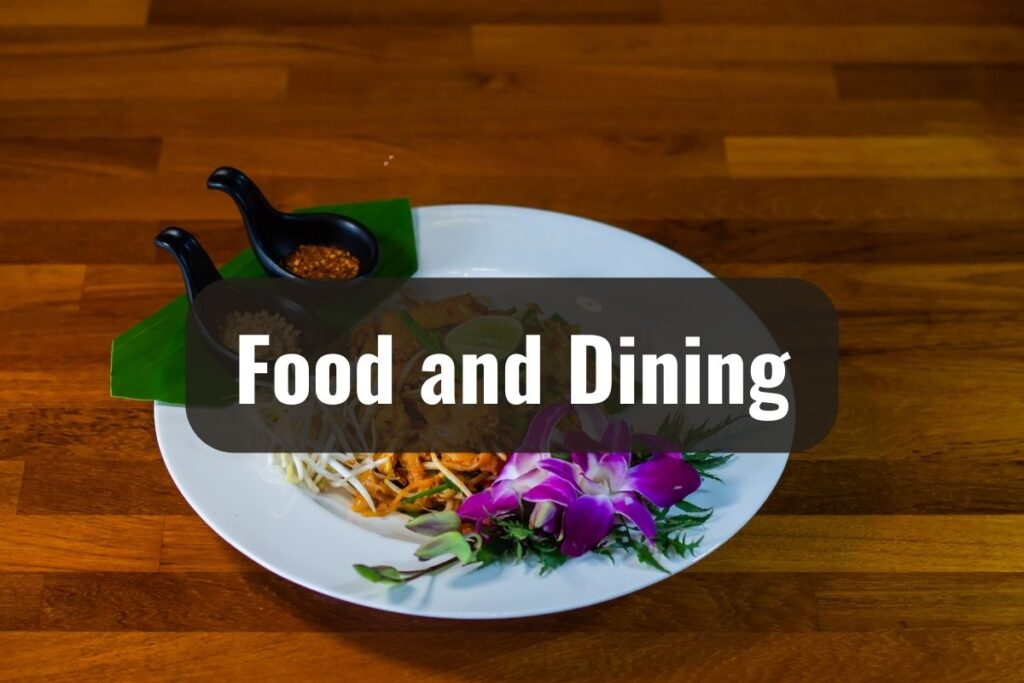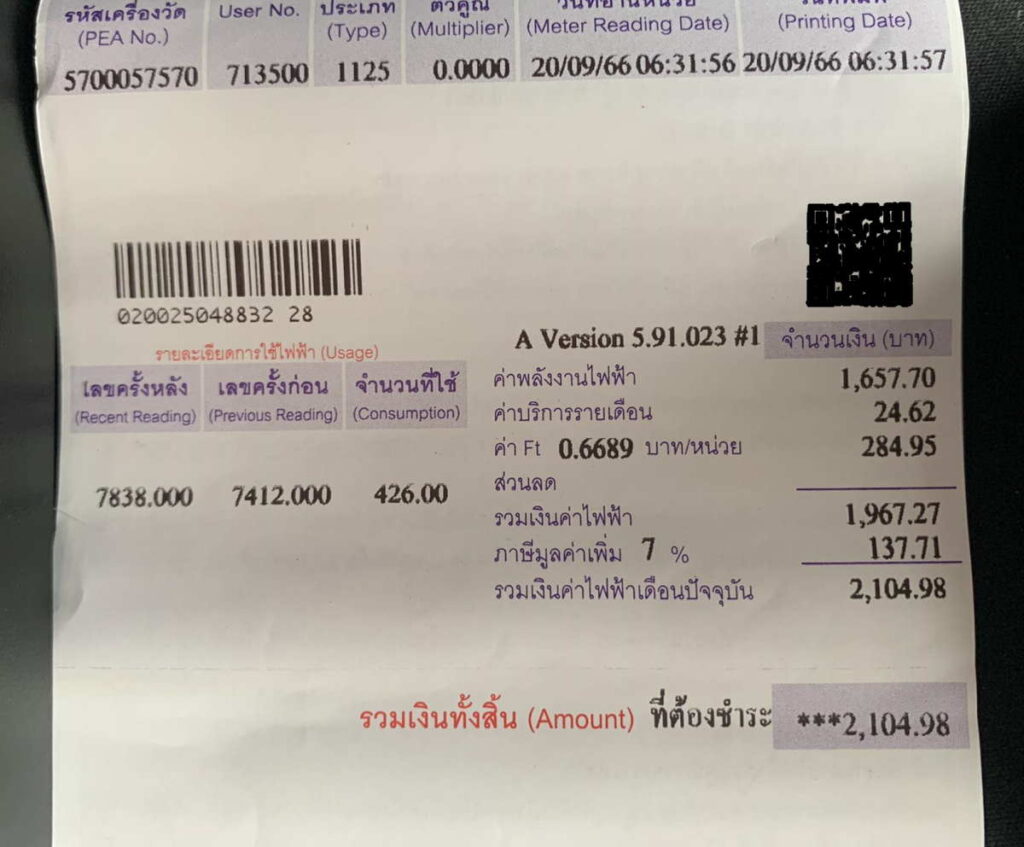Thailand, often referred to as the “Land of Smiles,” has long been a magnet for travelers, expatriates, and adventurers from all corners of the globe. One of the most pressing concerns for many is the cost of living. How much does it cost to rent an apartment in Bangkok compared to a beachside villa in Phuket? What’s the price of a hearty meal at a local eatery? How affordable is healthcare, and what about transportation?
Today, we’ll delve deep into the various aspects of daily expenses in Thailand, providing a comprehensive guide to help you confidently navigate your Thai journey.
KEY TAKEAWAYS
- Thailand offers diverse housing options, from city condos to traditional homes.
- Thai cuisine is affordable, with a mix of street food, local eateries, and upscale dining.
- Multiple transportation modes, from public buses to personal vehicles, facilitate easy movement.
- Both public and private healthcare institutions provide quality medical services.
- Thailand boasts a mix of local and international educational institutions for families.
- Compared to Western countries, Thailand offers a high quality of life at a fraction of the cost.
Housing and Accommodation
Thailand offers a diverse range of housing options, catering to different tastes, needs, and budgets. From the bustling heart of Bangkok with its modern condos to the serene countryside with traditional Thai homes, the choices are vast and varied.
City vs. Countryside
In major cities like Bangkok, Chiang Mai, and Phuket, the urban landscape is dominated by high-rise buildings, modern condominiums, and serviced apartments. These areas are often the hub of business, entertainment, and modern amenities, making them popular among young professionals and expatriates.
On the other hand, the countryside, including provinces like Isaan or regions in Northern Thailand, offers a more tranquil setting. Here, you’ll find traditional Thai houses, often made of wood, with spacious yards and a closer connection to nature. The pace of life is slower, and the surroundings are more serene.
Types of Accommodations and Their Costs
Apartments and Condos
These are the most common types of accommodations for foreigners in cities. They range from basic studio units to luxurious multi-bedroom suites. In Bangkok, for instance, a standard one-bedroom apartment in the city center might cost anywhere from 15,000 to 30,000 baht per month, depending on the location and amenities. In contrast, the same apartment in Chiang Mai might be priced between 10,000 and 20,000 baht.
Houses
Detached houses, whether in the city or the countryside, offer more space and privacy. In the city, a two-bedroom house might start at 25,000 baht per month, while in rural areas, the cost could be as low as 5,000 to 10,000 baht for a similar property.
Traditional Thai Homes
These are less common for long-term rentals but can be found in more rural settings. They offer a unique living experience, with wooden structures, elevated platforms, and open spaces. Renting such a home can vary widely based on its condition and location but expect prices to start from 8,000 baht in less touristy areas.
Factors Influencing Rental Prices
Several factors can influence the cost of housing in Thailand:
- Location: Properties in central areas or near popular attractions and amenities tend to be pricier.
- Amenities: Pools, gyms, security services, and other facilities can add to the rental cost.
- Age and Condition: Newer properties or those in excellent condition might command higher rents.
- Lease Duration: Longer lease terms might offer room for negotiation, potentially reducing monthly costs.
Food and Dining

Thailand’s culinary landscape is as diverse as its geography. From the spicy curries of the south to the tangy salads of the northeast, Thai cuisine offers a plethora of flavors that cater to every palate.
Eating Out: From Streets to Fine Dining
Street Food: One of the hallmarks of Thai cuisine is its vibrant street food scene. From bustling markets in Bangkok to quiet alleys in Chiang Rai, you’ll find vendors selling dishes like Pad Thai, Som Tam (papaya salad), and Moo Ping (grilled pork skewers). A hearty meal from a street vendor can cost as little as 30 to 100 baht, making it an affordable and delicious option for daily dining.
Local Restaurants: These establishments, often family-run, offer a more extensive menu than street vendors. Here, you can enjoy dishes like Green Curry, Tom Yum Goong (spicy shrimp soup), and Massaman Curry. A meal at a local restaurant typically ranges from 100 to 300 baht per person.
Upscale Dining: For those occasions when you want something more refined, Thailand’s cities boast a range of upscale restaurants, offering both Thai and international cuisines. Dining at these establishments can cost anywhere from 500 to 3,000 baht per person, depending on the restaurant’s prestige and location.
Grocery Shopping: Markets vs. Supermarkets

Local Markets
Thailand is dotted with local fresh markets where vendors sell everything from vegetables and fruits to meats and seafood. Shopping at these markets not only supports local businesses but is also often more affordable than supermarkets. For instance, a week’s worth of fresh produce for a single person might cost between 500 to 1,000 baht.
Supermarkets
Chains like Tesco Lotus, Big C, and Tops Market are prevalent in Thailand’s urban areas. They offer a broader range of products, including imported goods, which might be pricier than local equivalents.
A week’s grocery for a single person at a supermarket can range from 1,000 to 2,500 baht, depending on one’s preferences and the inclusion of imported items.
Popular Thai Dishes and Their Average Costs
To give readers a clearer picture, here are some popular Thai dishes and their average costs:
| Thai Dish | Average Cost (Baht) |
| Pad Thai | 40-80 |
| Green Curry with Rice | 60-150 |
| Tom Yum Goong | 100-300 |
| Mango Sticky Rice | 50-100 |
Embracing the Thai Culinary Experience
While the cost of food in Thailand can vary based on where and what you eat, one thing remains consistent: the explosion of flavors and the richness of the culinary tradition. Whether you’re savoring a spicy street food dish or indulging in a gourmet meal, Thailand’s food scene promises an unforgettable experience for every budget.
Transportation
Thailand’s diverse landscapes, from bustling urban centers to serene countryside, necessitate a robust transportation system. For foreigners, understanding the modes of transport and their associated costs is crucial for both daily commutes and exploratory travels.
Public Transportation: The Lifeline of Urban Thailand
Buses
Thailand’s bus network is extensive, especially in cities like Bangkok. Buses are an affordable way to travel, with fares ranging from 8 to 30 baht, depending on the type of bus and distance covered.
BTS (Skytrain) and MRT (Subway)
Predominantly in Bangkok, these rail systems are the go-to for many residents to avoid the city’s notorious traffic. Fares are distance-based, typically ranging from 15 to 60 baht.
Songthaews
These are shared pick-up trucks with two rows of seats in the back. Common in both cities and rural areas, fares usually range from 10 to 30 baht, depending on the distance.
Tuk-Tuks
These iconic three-wheeled vehicles are popular among tourists. While they offer a unique travel experience, they can be pricier than other modes. A short ride can cost anywhere from 50 to 200 baht, but always remember to negotiate the price before hopping in.
Personal and On-Demand Transportation
Taxis
Metered taxis are prevalent in cities. The starting fare is typically 35 baht, with incremental increases based on distance and time. A 10-kilometer ride might cost around 100 to 150 baht, excluding potential traffic-related surcharges.
Ride-Sharing Services
Platforms like Grab operate extensively in Thailand. They offer a convenient way to book rides, often at prices competitive with traditional taxis. Additionally, they provide food delivery and courier services.
Motorbikes and Scooters
Renting a motorbike or scooter is popular among both locals and expatriates, especially in towns like Chiang Mai or islands like Phuket. Monthly rentals can range from 2,000 to 6,000 baht, depending on the bike’s model and condition. If considering a purchase, a new scooter might cost between 40,000 to 70,000 baht.
Cars
While having a car provides comfort and convenience, it’s also a pricier option. Renting a basic sedan can cost from 15,000 to 30,000 baht per month. If considering a purchase, a new compact car’s price starts at around 600,000 baht.
The Road Less Traveled: Domestic Long-Distance Travel
Trains
Thailand’s railway network connects major cities and regions. Train travel offers scenic views, especially on routes like Bangkok to Chiang Mai. Prices vary based on class and distance, with a second-class air-conditioned seat from Bangkok to Chiang Mai costing around 800 to 1,000 baht.
Domestic Flights
With airlines like AirAsia, Nok Air, and Thai Lion Air, flying domestically is often time-efficient. Prices can vary widely based on the route and booking time, but promotional fares can be as low as 500 baht, excluding fees and taxes.
Charting Your Path in Thailand
Whether you’re zipping through Bangkok’s streets on a motorbike or embarking on a cross-country train journey, Thailand offers a plethora of transportation options to suit different needs and budgets. Being informed about these choices ensures seamless navigation through this captivating country.
Utilities and Connectivity

For many foreigners, the availability and cost of utilities and connectivity services play a significant role in ensuring a comfortable life in Thailand. From the cool breeze of an air conditioner to the convenience of high-speed internet, understanding the costs associated with these essentials is crucial.
Monthly Bills: Keeping the Lights On

Electricity: The cost of electricity in Thailand is based on consumption, with rates varying slightly depending on the region. On average, for a standard one-bedroom apartment, the monthly electricity bill can range from 1,000 to 3,000 baht. However, this can surge if air conditioning is used extensively.
Water: Water bills in Thailand are generally affordable. For the same one-bedroom apartment, the monthly water bill might range from 100 to 300 baht.
Gas: Many households in Thailand use bottled gas for cooking. A standard refill for a 15kg gas cylinder costs around 350 to 500 baht and can last a typical household several months, depending on usage.
Internet and Mobile Plans: Staying Connected
Internet: Thailand boasts a reasonably robust internet infrastructure, especially in urban areas. Several providers, including AIS, True, and 3BB, offer various packages. For a standard high-speed fiber-optic connection (around 100 Mbps), monthly charges range from 600 to 1,200 baht.
Mobile Plans: Mobile connectivity is excellent in Thailand, with providers like AIS, DTAC, and True offering a range of postpaid and prepaid plans. For a typical postpaid plan with unlimited calls and a generous data allowance, monthly charges can range from 300 to 800 baht. Prepaid options are flexible, with data packages starting as low as 50 baht for a few days of usage.
Cable TV and Streaming Services
Cable TV: Several providers offer cable TV packages with a mix of local and international channels. Monthly charges for a standard package can range from 300 to 1,000 baht.
Streaming Services: With the global shift towards streaming, platforms like Netflix, Disney+, and local services like AIS Play are gaining popularity in Thailand. Monthly subscriptions for these platforms can range from 100 to 500 baht, depending on the service and package chosen.
Staying Informed and Entertained
While the cost of utilities and connectivity in Thailand can vary based on usage and chosen providers, the country offers a range of options to ensure residents stay powered and connected. Whether you’re streaming your favorite show, making international calls, or simply enjoying a cool room on a hot day, Thailand’s modern amenities ensure a comfortable and connected lifestyle.
Healthcare
Thailand’s healthcare system has garnered international recognition for its quality and affordability. With state-of-the-art hospitals, skilled medical professionals, and a range of public and private facilities, the country ensures both its residents and numerous medical tourists are well taken care of.
Public vs. Private Hospitals: A Comparative Glance
Public Hospitals: These are government-run institutions that provide medical services to Thai citizens at subsidized rates. While foreigners can also access these facilities, the charges are typically higher for them compared to locals. However, even at these higher rates, public hospitals can be more affordable than private ones. The quality of care is generally good, but one might encounter longer wait times and fewer English-speaking staff.
Private Hospitals: Thailand’s private hospitals, especially in major cities, are known for their high standards of care. Many of these hospitals cater to international patients, offering state-of-the-art facilities, English-speaking staff, and a range of specialized services. Naturally, the cost of treatment at private hospitals is higher. For instance, a general consultation with a specialist might range from 1,000 to 2,500 baht, depending on the hospital and the doctor’s expertise.
Average Cost of Common Medical Procedures
To provide a clearer perspective on healthcare costs, here are some average prices for standard procedures in private hospitals:
- General Doctor Consultation: 500 to 1,500 baht
- Dental Cleaning: 800 to 2,000 baht
- Blood Tests: 1,000 to 3,000 baht, depending on the complexity
- X-rays: 1,000 to 2,500 baht
- MRI Scan: 8,000 to 15,000 baht
It’s essential to note that these are approximate figures, and actual costs can vary based on the hospital, location, and specific patient needs.
Health Insurance Options for Foreigners
Given the potential medical expenses, many foreigners opt for health insurance to mitigate costs. Several international and local insurance providers offer plans tailored to expatriates and long-term residents. Coverage can range from basic outpatient care to comprehensive plans that include specialized treatments and even medical evacuation.
Premiums for these insurance plans can vary widely based on coverage, age, and any pre-existing conditions. On average, a comprehensive health insurance plan might cost anywhere from 20,000 to 100,000 baht annually.
Prioritizing Health in the Land of Smiles
Thailand’s healthcare system offers a blend of quality, accessibility, and affordability. Whether one chooses public or private care, the country ensures that medical needs are met with professionalism and care.
Entertainment and Leisure

Thailand, with its rich cultural tapestry, natural beauty, and modern amenities, offers a plethora of entertainment and leisure options. From the serene temples and traditional performances to the vibrant nightlife and modern cinemas, there’s something for everyone.
Popular Tourist Attractions: A Blend of History and Nature
Temples and Historical Sites
Thailand is home to thousands of temples, with some like Wat Phra Kaew in Bangkok and Wat Pho being iconic landmarks. Entrance fees for foreigners can range from 50 to 500 baht, depending on the site’s significance.
National Parks and Beaches
With destinations like the Phi Phi Islands, Erawan National Park, and Similan Islands, Thailand’s natural beauty is a major draw. Entrance fees for national parks typically range from 200 to 400 baht for foreigners.
Museums and Cultural Centers
Institutions like the Bangkok National Museum or the Jim Thompson House offer insights into Thai history and culture. Admission prices vary but generally fall between 100 to 300 baht.
Nightlife: From Tranquil Beach Bars to Bustling Clubs
Bars and Pubs: Whether it’s a rooftop bar in Bangkok or a beachside shack in Koh Samui, Thailand’s bar scene caters to diverse preferences. A local beer might cost between 60 to 150 baht, while cocktails can range from 150 to 500 baht, depending on the establishment’s location and prestige.
Nightclubs: Cities like Bangkok and Pattaya are known for their vibrant club scenes. Entrance fees can vary, with some clubs offering free entry while others might charge between 200 to 1,000 baht, often inclusive of a drink.
Live Shows and Performances: Traditional Thai dance shows, cabaret performances, and Muay Thai matches are popular entertainment forms. Ticket prices can range from 500 to 2,500 baht, depending on the show’s nature and venue.
Recreational Activities: Fitness, Adventure, and Relaxation
Gyms and Fitness Centers: From local gyms to international chains like Fitness First, there are plenty of options for those looking to stay fit. Monthly memberships can range from 500 baht for basic local gyms to 2,500 baht for premium fitness centers.
Outdoor Adventures: Activities like scuba diving, trekking, and zip-lining are popular among adventure enthusiasts. For instance, a basic scuba diving course might cost between 10,000 to 15,000 baht.
Spas and Wellness Centers: Thailand is renowned for its massages and spa treatments. A traditional Thai massage can cost anywhere from 200 to 1,000 baht per hour, depending on the spa’s location and luxury level.
Crafting Memorable Moments in Thailand
Thailand’s entertainment and leisure scene is as diverse as its landscapes. Whether you’re a history buff, a party enthusiast, or someone seeking relaxation, the country promises memorable experiences for every budget. Exploring these options and understanding their costs ensures that every moment spent in Thailand is filled with joy and excitement.
Education
For families with children or individuals seeking further education, Thailand’s educational landscape offers a mix of local institutions and international establishments. From traditional Thai schools that immerse students in local culture and language to international schools that follow globally recognized curricula, there are options to suit various educational needs and preferences.
International Schools: A Global Perspective in Thailand
Overview: International schools in Thailand primarily cater to the expatriate community, offering curricula from countries like the UK, US, Australia, and the International Baccalaureate program. These schools often boast state-of-the-art facilities, extracurricular activities, and a multicultural environment.
Costs: Tuition fees at international schools can vary widely based on the school’s reputation, location, and facilities. On average:
- Kindergarten: 200,000 to 500,000 baht per year
- Primary School: 400,000 to 800,000 baht per year
- Secondary School: 500,000 to 1,200,000 baht per year
Local Schools: Immersion in Thai Education
Overview: Local schools in Thailand follow the national curriculum, with a strong emphasis on the Thai language and culture. While the medium of instruction is primarily Thai, many schools now offer English programs where core subjects are taught in English.
Costs: Public local schools are highly subsidized, making them an affordable option for residents. Annual fees can range from 5,000 to 50,000 baht, depending on the school and the specific program. Private Thai schools, offering better facilities and smaller class sizes, might charge between 50,000 to 200,000 baht annually.
Tertiary Education: Universities and Vocational Training
Universities: Thailand is home to several renowned universities, both public and private. For undergraduate programs, annual tuition fees can range from 50,000 to 150,000 baht for local universities. International programs, which are taught in English, might have fees ranging from 100,000 to 300,000 baht per year.
Vocational and Language Schools: For those looking to learn a new skill or pick up the Thai language, numerous vocational and language schools offer courses. Costs can vary based on the course’s duration and content, but a standard Thai language course might cost between 5,000 to 15,000 baht for a few months.
Nurturing Minds in the Land of Smiles
Whether it’s the early years of kindergarten or the pursuit of a university degree, Thailand’s education system offers diverse pathways for academic and personal growth. For families and individuals, understanding the educational landscape and associated costs ensures informed decisions, laying the foundation for a bright future in Thailand.
Miscellaneous Expenses

While major categories like housing, food, and healthcare often dominate discussions about living costs, there are numerous smaller, miscellaneous expenses that can add up over time. These can range from personal care items to occasional indulgences or cultural practices unique to Thailand.
Clothing and Personal Care
Local Markets and Street Vendors: Thailand’s markets, such as Chatuchak in Bangkok, offer a wide range of clothing at affordable prices. A T-shirt might cost between 100 to 300 baht, while trousers or dresses can range from 200 to 600 baht.
Malls and Branded Stores: For branded clothing or more upscale shopping, malls like CentralWorld or Siam Paragon are popular destinations. Here, prices align more with international standards, with shirts ranging from 500 to 2,000 baht and more premium brands commanding higher prices.
Personal Care Products: Items like shampoo, soap, or toothpaste are readily available in supermarkets and convenience stores. Prices are comparable to international standards, with a bottle of shampoo costing between 80 to 200 baht, depending on the brand.
Gifts and Souvenirs
Handicrafts: Thailand is renowned for its handicrafts, from silk scarves to wooden carvings. Depending on the intricacy and origin, a silk scarf might cost between 300 to 1,500 baht.
Local Delicacies: Items like dried mango, Thai tea, or local spices make popular gifts. A pack of dried fruit might range from 50 to 200 baht, depending on the quantity and brand.
Donations and Temple Offerings
Engaging in local cultural practices, many foreigners and residents make offerings at temples or donate during festivals. While these are voluntary:
Temple Offerings: Offerings, like flowers or incense, can be purchased for as little as 20 to 100 baht.
Donations: During events or festivals, locals and foreigners might donate anywhere from 20 baht to a few thousand, depending on personal preference and capability.
Occasional Indulgences
Books and Magazines: English books and magazines are available in major bookstores and can range from 200 to 1,000 baht, depending on the title.
Cafes and Coffee Shops: A cup of coffee in a local cafe might cost between 60 to 150 baht, while international chains like Starbucks might charge between 100 to 250 baht.
Preparing for the Unexpected
Life is full of surprises, and occasionally, unexpected expenses arise. Setting aside a monthly contingency fund can be wise. This could be anywhere from 1,000 to 5,000 baht, depending on one’s overall budget and comfort level.
Piecing Together the Financial Puzzle
While miscellaneous expenses might seem minor in isolation, collectively, they contribute to the overall cost of living in Thailand. By being aware of these costs and budgeting for them, foreigners can ensure a smooth, stress-free experience, fully immersing themselves in all that Thailand has to offer.
Costs in Thailand vs. Western Countries
When considering a move to a new country, one of the most significant factors influencing the decision is the cost of living. How does Thailand, with its tropical allure and rich cultural tapestry, compare to Western countries in terms of expenses?
Housing and Accommodation
In major Western cities, whether it’s New York, London, or Sydney, the cost of renting an apartment or house is considerably higher than in Thai cities like Bangkok or Chiang Mai. While a one-bedroom apartment in the city center of Bangkok might range from 15,000 to 30,000 baht, the equivalent in a city like London could easily be four to five times that amount.
However, when comparing amenities, many Thai accommodations, especially in newer condos, offer facilities like pools and gyms, which might be premium-priced amenities in Western counterparts.
Food and Dining
Western countries, with their diverse culinary scenes, offer a wide range of dining options. However, when it comes to affordability, Thailand’s street food and local restaurants are hard to beat.
A hearty meal that costs 50 to 150 baht in Thailand might be equivalent to a fast-food meal in the West, which often costs considerably more. Grocery prices, especially for local produce in Thailand, are also generally lower than in Western supermarkets.
Transportation
Public transportation costs in Thailand are typically lower than in Western countries. A subway ride in Bangkok might cost between 15 to 60 baht, while a similar journey in New York or London could be three to four times that price.
Personal vehicles, however, are more comparably priced, with cars and motorbikes in Thailand sometimes costing as much as, if not more than, in some Western countries.
Healthcare
While Thailand’s private healthcare might seem expensive to locals, it’s often more affordable than medical services in many Western countries, especially the US. Even without insurance, many medical procedures and consultations in Thailand can be a fraction of what they would cost in Western nations. Quality, especially in top private hospitals, is on par with Western standards.
Education
International schools in Thailand, offering Western curricula, might seem expensive locally. However, when compared to private education costs in countries like the US or UK, they often come out as more affordable. University tuition, especially for international programs in Thailand, is also generally lower than in Western institutions.
Miscellaneous and Leisure
Entertainment, leisure activities, and miscellaneous expenses like clothing or personal care are generally more affordable in Thailand. Whether it’s a spa day, a cinema ticket, or a shopping spree, one’s money often goes further in Thailand than in many Western settings.
The Bigger Picture
While this comparative analysis provides a general overview, individual experiences can vary based on lifestyle choices, preferences, and personal circumstances. However, one consistent theme emerges: Thailand offers a high quality of life, rich experiences, and modern amenities, often at a fraction of the cost of many Western countries. This balance of cost and quality makes it an attractive destination for many looking to relocate or spend extended periods abroad.


